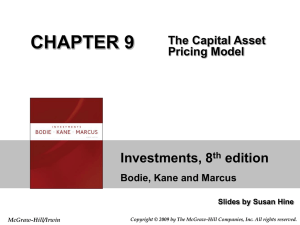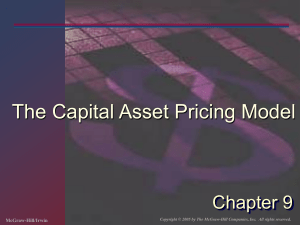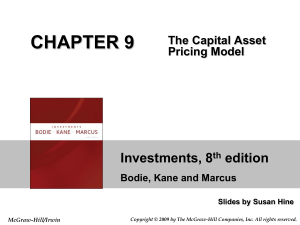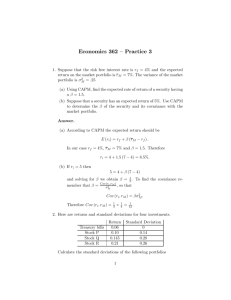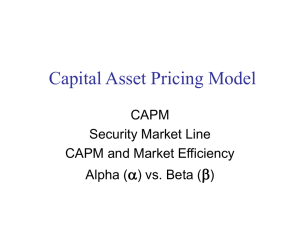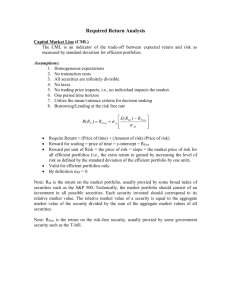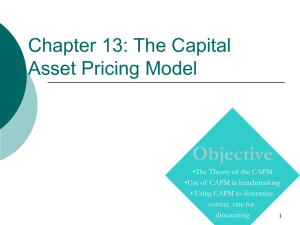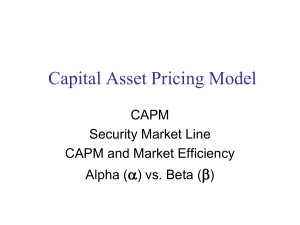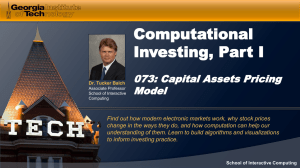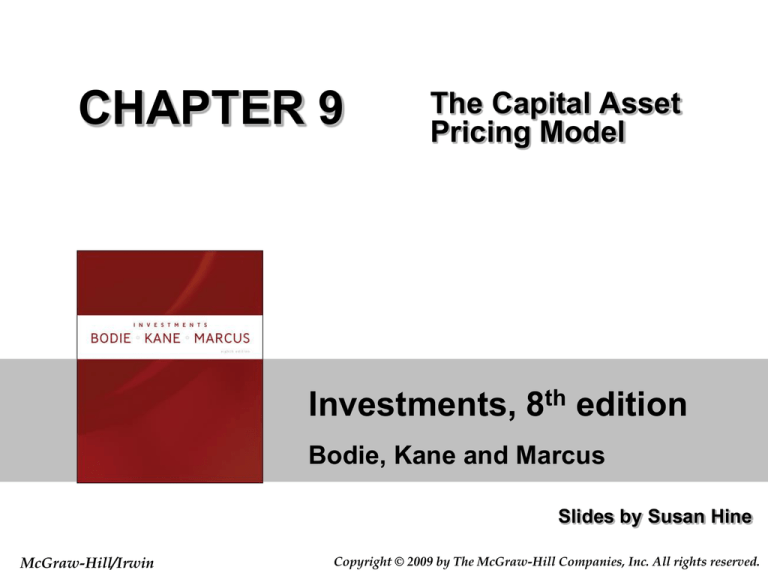
CHAPTER 9
The Capital Asset
Pricing Model
Investments, 8th edition
Bodie, Kane and Marcus
Slides by Susan Hine
McGraw-Hill/Irwin
Copyright © 2009 by The McGraw-Hill Companies, Inc. All rights reserved.
Capital Asset Pricing Model (CAPM)
• It is the equilibrium model that underlies all
modern financial theory
• Derived using principles of diversification with
simplified assumptions
• Markowitz, Sharpe, Lintner and Mossin are
researchers credited with its development
9-2
Assumptions
• Individual investors are price takers
• Single-period investment horizon
– Can be extended to: All agents plan for the same
time horizon (and information changes between
“planning periods” are very predictable)
• Investments are limited to traded financial
assets
• No taxes and transaction costs
– Like liquidity costs
9-3
Assumptions Continued
• Information is costless and available to all
investors
• Investors are rational mean-variance
optimizers
• There are homogeneous expectations
9-4
Resulting Equilibrium Conditions
• All investors will hold the same portfolio for
risky assets – market portfolio
• Market portfolio contains all securities and
the proportion of each security is its market
value as a percentage of total market value
– This is a solution to problem of maximizing
Sharpe Ratio.
9-5
Resulting Equilibrium Conditions
Continued
• Risk premium on the market depends on the
average risk aversion of all market
participants
• Risk premium on an individual security is a
function of its covariance with the market
9-6
Figure 9.1 The Efficient Frontier and the
Capital Market Line
9-7
Market Risk Premium
•The risk premium on the market portfolio will
be proportional to its risk and the degree of risk
aversion of the average investor.
– (see CAPM-presentation2.pdf for more detail)
9-8
Return and Risk For Individual Securities
• The risk premium on individual securities is a
function of the individual security’s
contribution to the risk of the market portfolio
• An individual security’s risk premium is a
function of the covariance of returns with the
assets that make up the market portfolio
9-9
Using GE Text Example
• Covariance of GE return with the market
portfolio:
CovwGE rGE , rM wGE CovrGE , rM
• Therefore, the reward-to-risk ratio for
investments in GE would be:
GE' s contrib. to RiskP remium wGE ErGE rf E rM rf
GE' s contrib. toVariance
wGE CovrGE , rM
M2
9-10
Using GE Text Example Continued
• Reward-to-risk ratio for investment in
market portfolio:
Mkt RP E rM rf
MktVar
M2
• Reward-to-risk ratios of GE and the market
portfolio:
E rGE rf
E rM rf
CovrGE , rM
M2
• And the risk premium for GE:
E rGE rf
CovrGE , rM ErM rf
M2
9-11
Figure 9.2 The Security Market Line
9-12
CAPM APPLICATIONS
• Buy or sell stocks (SML)
– This first one we talked about it last class, and we cover it in the next
slides
• IRR (Internal rate of return) cut-offs, or hurdle-rate
• Note that any allocation of resources imply a opportunity cost
problem
– Invest $100 on some project or in the market?
• The CAPM gives a required expected rate of return for such
projects.
– Example: Company invests $100 million on project with beta of .5 and
the market (expected) return is 14% and T-bill rate is 6%. The implied
required return is 6%+.5(8%)=10%.
– Project should generate (at least) $10 million profits.
9-13
Figure 9.3 The SML and a PositiveAlpha Stock
• Alpha for a stock is the
difference between
expected return in
excess of the fair
expected return as
predicted by the CAPM
•
Fair expected return always
plot on the SML
• In the picture to the left
we have a positive alpha
stock (17-15.6)>0
9-14
In class exercise (SML use)
• Stock XYZ has expected return of 12% and
beta is 1. Stock ABC has expected return of
13% and beta is 1.5. Market expected return
is 11% and risk-free rate is 5%.
– Which stock is a better buy (based on CAPM)?
– Compute alpha for each stock. Plot the SML and indicate
alpha for each stock
9-15
In class exercise (CAPM as hurdle rate)
• You have a project opportunity for which you
know it to have a beta of 1.3. You also know
that the risk-free rate is 8% and expected
return on the market portfolio is 16%.
•
•
Would you invest in this project? In other words, what is the required
internal rate of return (hurdle rate) implied by the CAPM for this project.
If the expected return is 19% would you invest in this project?
9-16
The Index Model and Realized Returns
• To move from expected to realized returns—
use the index model in excess return form:
Ri i i RM ei
– Stock alpha is not the same alpha in the eq.
above
– The index model beta coefficient turns out to be
the same beta as that of the CAPM expected
return-beta relationship
9-17
Figure 9.4 Estimates of Individual Mutual
Fund Alphas, 1972-1991
•
There are “expost”, or after the
fact, alphas
•
Ex-ante alpha, in
equilibrium, is
zero.
9-18
The CAPM and Reality
• Is the condition of zero alphas for all stocks
as implied by the CAPM met
– Not perfect but one of the best available
• Is the CAPM testable
– Proxies must be used for the market
portfolio
• CAPM is still considered the best available
description of security pricing and is widely
accepted
9-19

